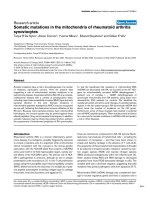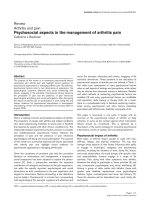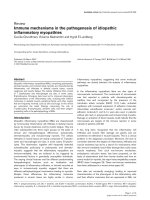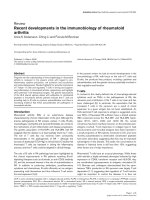Báo cáo y học: "Joining forces in the quest for orthologs" ppsx
Bạn đang xem bản rút gọn của tài liệu. Xem và tải ngay bản đầy đủ của tài liệu tại đây (170.53 KB, 3 trang )
Gabaldón et al.: Genome Biology 2009, 10:403
Abstract
Better orthology-prediction resources would be beneficial for the
whole biological community. A recent meeting discussed how to
coordinate and leverage current efforts.
Identifying evolutionarily related genes (that is, homologs)
is crucial for understanding the nature of genomic diversity
and the routes by which it arises. Further, distinguishing
homologs into two types, either ‘orthologs’, genes derived
from a common ancestor through speciation, or ‘paralogs’,
those derived through a duplication event, has important
implications in studying the evolutionary processes that
have shaped a given biological system and, since gene
duplication is often associated with processes of functional
divergence, for inferring the function of related genes.
Indeed, many common research processes depend on
accurate orthology predictions, such as finding the gene in
a model organism corresponding to a human disease gene,
inferring the function of a newly sequenced gene using
available experimental assays from its orthologs, inferring
species phylogenies by tracing the evolution of orthologous
groups, or the characterization of newly sequenced
genomes in terms of their encoded genes.
The challenge today, however, is not a lack of orthology
predictions, but the plethora of methods and databases that
have emerged in recent years (reviewed in [1-3]; additional
methods include [4-7]). These methods were developed to
meet individual needs - they analyze different datasets,
optimize different criteria, and employ different strategies
for orthology determination (for example, pairwise com-
parisons or phylogenetic approaches). Such heterogeneity
presents a major obstacle to researchers who simply need to
know the current ‘best’ set of orthologs that can be identified
for their gene of interest. Furthermore, the absence of
standardized benchmarks and formats makes the inte-
gration or comparison of these different orthology datasets
extremely challenging and time-consuming.
The field of orthology prediction clearly requires a new
momentum that will help resolve these issues and make
better use of available resources. Furthermore, this need
becomes more urgent when considering the advent of
thousands of new genome sequences, facilitated by next-
generation sequencing technologies. Motivated by this
prospect, Erik Sonnhammer and Albert Vilella organized
the ‘Quest for Orthologs’ meeting at the Wellcome Trust
Conference Centre in Hinxton, UK in July 2009, to jointly
address these issues by bringing together for the first time
key representatives of the major methods and databases in
the field of orthology prediction.
The participants gathered for this meeting included experts
in gene and genome evolution, developers of orthology-
prediction algorithms and databases, and curators of
model organism databases. The intimate size of the
meeting (approximately 30), the varied perspectives, and
the sequestered venue created an ideal environment for
intensive and fruitful discussions. All participants were
given an opportunity to present their work, while still
allowing ample time for informal discussion afterwards. In
a thought-provoking talk, Bill Pearson (University of
Virginia, Charlottesville, USA) confronted the audience
head on by questioning the usefulness of orthology. In his
view, homology inference is a more reliable indicator of
function conservation, as far as purely sequence-based
methods are concerned (though he also stressed the
inherent limitations of such methods over long evolu-
tionary distances). He noted that function is often
conserved between paralogs; and even if not, the potential
benefits of distinguishing orthologs from paralogs are
outweighed by the risks of inference errors. Teresa
Przytycka (National Center for Biotechnology Information,
Bethesda, USA) and Ken Wolfe (Smurfit Institute of
Genetics, Dublin, Ireland) gave two examples of how
augmenting current methods with additional information
(protein-protein interaction and synteny data, respectively)
might improve predictions. In contrast, most algorithmic
Correspondence
Joining forces in the quest for orthologs
Toni Gabaldón*, Christophe Dessimoz
†
, Julie Huxley-Jones
‡
, Albert J Vilella
§
,
Erik LL Sonnhammer
¶
and Suzanna Lewis
¥
Addresses: *Bioinformatics and Genomics Programme, Centre for Genomic Regulacion (CRG), Dr. Aiguader, 88. 0800, Barcelona, Spain.
†
ETH Zurich and Swiss Institute of Bioinformatics, 8092 Zurich, Switzerland.
‡
Computational Biology, GlaxoSmithKline Pharmaceuticals,
Gunnels Wood Road, Stevenage, Hertfordshire SG1 2NY, UK.
§
European Bioinformatics Institute, Wellcome Trust Genome Campus,
Hinxton, Cambridge CB10 1SD, UK.
¶
Stockholm Bioinformatics Centre, AlbaNova University Centre, Stockholm University, S-106 91
Stockholm, Sweden.
¥
Lawrence Berkeley National Laboratory, 1 Cyclotron Road 64R0121, Berkeley, CA 94618, USA.
Correspondence: Toni Gabaldón. Email:
403.2
Gabaldón et al.: Genome Biology 2009, 10:403
developments presented at the meeting suggest a general
trend toward phylogeny-based orthology inference, a
strategy that resembles more closely the original definition
of orthology [8]. From all the discussions it was clear that
there is a lack of research in the conservation and evolution
of protein function. Relevant research will only be possible
on the basis of accurately predicted gene histories and
functional annotations.
However, the major thrust of the meeting was on
identifying points of intersection and the immediate steps
that could be jointly undertaken following the workshop to
lay the groundwork for the future. As Mike Cherry
(Stanford University, Stanford, USA), Pascale Gaudet
(Northwestern University, Evanston, USA) and Paul
Thomas (SRI International, Menlo Park, USA) explicitly
pointed out, and we all clearly recognized, orthologs are
essential for more accurately assigning function and the
lack of coordination in the field is a major roadblock to
progress in this area. Two primary areas for cooperative
work were quickly identified: common approaches to
benchmark orthology predictions and the formation of
standardized protein sets to use as inputs.
Benchmarking orthology-prediction methods
coming from alternative methods
The assessment of orthology-prediction methods is difficult
for at least three reasons: first, orthology is defined from the
largely unknown evolutionary history of genes, and thus can
only be tested indirectly; second, the optimal trade-off
between precision and recall strongly depends on the
context; and third, the lack of standardized input datasets
and data formats are significant practical hurdles to
comparing methods. The meeting saw contributions
addressing all three issues. David Roos (University of
Pennsylvania, Philadelphia, USA) and Adrian Altenhoff
(ETH Zurich, Switzerland) introduced novel comparison
strategies - based on latent class analysis and species-tree
concordance, respectively [9,10] - that complement existing
approaches based on gene order and functional conservation
[11]. Yet all of these benchmarks rely on assumptions that do
not always hold. For instance, genomic rearrangements,
recombination, alternative evolu tionary histories, or
functional divergence among orthologs all disturb these
indicators. More importantly, their relative importance
strongly depends on the aim of the user. Thus, we not only
recognized the usefulness of multiple and at times
contradictory criteria, but also the need for a common
understanding on their usage and interpretation. Finally, we
agreed that adopting a common dataset would eliminate
inconsistent use of splicing variants, IDs or data sources
and, therefore, greatly facilitate benchmarking.
Standardized protein datasets and file formats
We identified the ideal common dataset as one that covers
a wide spectrum of evolutionary ranges and rates, and that
reflects the various common applications of orthology (for
example, phylogenetic reconstruction, function prediction,
synteny and so on). A working group was established, an
initial set of species was proposed (based on earlier work of
Paul Thomas, Brigitte Boeckmann and Suzanna Lewis),
and it is anticipated that this dataset will be available very
soon. Rolf Apweiler (European Bioinformatics Institute,
Hinxton, USA) offered that UniProt maintain the set.
Regarding the need for standardized input and output data
formats, Erik Sonnhammer introduced early specifications
of an eXtensible Markup Language (XML) format for
orthology, OrthoXML [12], which ignited discussions on
potential improvements and compatibility issues with
existing methods. Such a format would not only facilitate
the comparison of methods, but also their combination.
For instance, Roos among others suggested a common web
interface to the different predictions methods - similar to
HPOC [13] and ProGMap [14], the orthology aggregators
presented by Michael Lush (European Bioinformatics
Institute, Hinxton, UK) and Jack Leunissen (Wageningen
University, the Netherlands), respectively. Several working
groups have been set up to further develop these ideas and
help their realization. Readers interested in participating
should contact us.
In retrospect, a remarkable aspect of this meeting is how
few of us, despite our strong common interests and goals,
had previously met in person. Yet this is an essential first
step for building and coordinating collaborative efforts.
Given the positive outcomes of this workshop, we are
planning to gather again next year to follow up this work
and build on the momentum this meeting generated.
Acknowledgements
We are grateful to the European Science Foundation and the
Wellcome Trust for their generous support, which made this meeting
possible, to Pam Garland for coordinating our many requests and
making sure we ran on time, to all participants in the meeting for
their valuable ideas, and to Michael Ashburner from whom the idea
for this valuable workshop also originated.
References
1. Gabaldón T: Large-scale assignment of orthology: back to
phylogenetics? Genome Biol 2008, 9:235.
2. Kuzniar A, van Ham RC, Pongor S, Leunissen JA: The quest
for orthologs: finding the corresponding gene across
genomes. Trends Genet 2008, 24:539-551.
3. Alexeyenko A, Lindberg J, Perez-Bercoff A, Sonnhammer EL:
Overview and comparison of ortholog databases. Drug
Disc Today: Technologies 2006, 3:137-143.
4. Datta RS, Meacham C, Samad B, Neyer C, Sjolander K:
Berkeley PHOG: PhyloFacts orthology group prediction
web server. Nucleic Acids Res 2009, 37(Web Server
issue):W84-W89.
5. Jensen LJ, Julien P, Kuhn M, von Mering C, Muller J, Doerks T,
Bork P: eggNOG: automated construction and annotation
of orthologous groups of genes. Nucleic Acids Res 2008,
36(Database issue):D250-D254.
6. Uchiyama I: MBGD: a platform for microbial comparative
genomics based on the automated construction of ortholo-
gous groups. Nucleic Acids Res 2007, 35(Database
issue):D343-D346.
403.3
Gabaldón et al.: Genome Biology 2009, 10:403
7. Roth AC, Gonnet GH, Dessimoz C: Algorithm of OMA for
large-scale orthology inference. BMC Bioinformatics 2008,
9:518.
8. Fitch WM: Distinguishing homologous from analogous pro-
teins. Syst Zool 1970, 19:99-113.
9. Altenhoff AM, Dessimoz C: Phylogenetic and functional
assessment of orthologs inference projects and methods.
PLoS Comput Biol 2009, 5:e1000262.
10. Chen F, Mackey AJ, Vermunt JK, Roos DS: Assessing perfor-
mance of orthology detection strategies applied to eukary-
otic genomes. PLoS One 2007, 2:e383.
11. Hulsen T, Huynen MA, de Vlieg J, Groenen PM: Benchmarking
ortholog identification methods using functional genomics
data. Genome Biol 2006, 7:R31.
12. OrthoXML []
13. Bruford EA, Lush MJ, Wright MW, Sneddon TP, Povey S,
Birney E: The HGNC Database in 2008: a resource for the
human genome. Nucleic Acids Res 2008, 36(Database
issue): D445-D448.
14. Kuzniar A, Lin K, He Y, Nijveen H, Pongor S, Leunissen JA:
ProGMap: an integrated annotation resource for protein
orthology. Nucleic Acids Res 2009, 37(Web Server issue):
W428-W434.
Published: 29 September 2009
doi:10.1186/gb-2009-10-9-403
© 2009 BioMed Central Ltd









